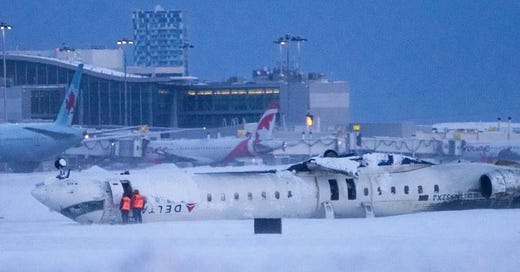I’m not a fan of flying. After 25+ years of travelling the world for business, I started driving to my bi-weekly onsite consulting gig in Toronto. Travel by air just got to be a major hassle. Less Stress + More Control = Lower Blood Pressure!
That was then. Having not flown in over 10 years, I can’t imagine the flying experience has gotten any better. What I’ve seen the last several years is that airliners are giant busses in the sky loaded with a bunch of angry, unruly passengers. Yuk.
I’ve never been afraid of flying. Luckily, I’ve never had any bad experiences when travelling by air and, if I desired, I would get on a plane tomorrow.
But the news of late has been a bit disconcerting. It seems like every other day there’s a new airplane crash or near miss. Some have had fatalities. So far, there have been at least 145 aviation accidents in the first two months of 2025, according to the National Transportation Safety Board, including:
67 people were killed during a collision between an American Airlines regional jet and an Army helicopter near Ronald Reagan National Airport in Washington, D.C.
A non-fatal crash in which a Delta flight flipped upside down upon landing in Toronto.
A medevac jet crashed in Philadelphia, killing six people onboard and one person on the ground.
A private jet landing in Scottsdale, Arizona collided with a parked plane killing one.
10 people perished when a regional jet crashed near Nome, Alaska.
A skydiving plane crashed in Florida, killing the pilot.
From all reports, it seems like air travel has become much more dangerous. It seems like there are constantly news reports of air disasters.
But is air travel more dangerous? Have air accidents suddenly become more prevalent?
Last year, there were 1,417 aviation crashes. In January, there were 80 crashes and 93 in February. There were 258 fatal plane crashes in 2024, with 19 in January and 12 in February. (See the National Transportation Safety Board statistics at the end of this story.)
So far this year, there have been 145 aviation accidents, with 67 total crashes in January and 78 in February. 21 of these crashes were fatal, 11 in January and 10 in February.
Regardless of the recent news, air travel is getting safer.
In their 2024 safety report, the International Air Transport Association (IATA) calculated that last year saw one accident for every 880,000 flights and one fatal accident out of 5.8 million flights. That’s a contrast of 2011-2015 where the five-year average was one accident for every 456,000 flights.
According to the FAA, an average of 45,000 commercial and private flights take off each day in the U.S., carrying 2.9 million passengers across 29 million sq. mi of air space. For all that, any one person’s odds of dying in an air disaster are very small—about one in 13.7 million according to a 2024 study from the Massachusetts Institute of Technology. (In comparison, the odds of dying in a car accident are 1 in 95.)
But mistakes happen. According to the Pilot Institute, in 2020 69.1% of all accidents are caused by pilot error:
In a way the concerns over air safety remind me of the movie Jaws. Before the 1975 movie, shark attacks were common but they weren’t something most folks thought about when heading to the beach. After the movie the media started covering shark attacks and that’s all people thought about. The number of shark attacks didn’t increase after the movie; our recognition of their numbers did.
I believe that a number of high casualty air crashes heightened the public’s perception of air safety, not that there has been a decrease in the level of air safety.
* Thanks to my daughter for suggesting this topic.
==============================
The number of non-fatal aircraft accidents
The number of fatal aircraft accidents






